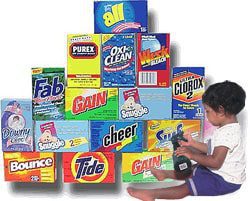
Laundry detergents are being linked with child poisonings especially in toddlers attracted to those convenient and colorful pod packs that are becoming quite popular. Children are mistaking the detergent pods for candy, said the Orange County Register (OC Register). Richard Geller, MD, MPH, Medical Director for the California Poison Control System (CPCS) at Children’s Hospital, […]
 Laundry detergents are being linked with child poisonings especially in toddlers attracted to those convenient and colorful pod packs that are becoming quite popular.
Laundry detergents are being linked with child poisonings especially in toddlers attracted to those convenient and colorful pod packs that are becoming quite popular.
Children are mistaking the detergent pods for candy, said the Orange County Register (OC Register). Richard Geller, MD, MPH, Medical Director for the California Poison Control System (CPCS) at Children’s Hospital, Madera, told the OC Register that 82 cases of poisoning reported in May in California were linked to the pods.
In a recent 72-hour period, noted Yahoo Health, nine toddler poisonings were reported to the CPCS. Nationally, no less than 250 cases have been reported to poison control centers in 2012 and, most, since March, when the products gained popularity in stores.
“Poison control centers are seeing more pediatric poisonings from laundry detergent this year, and the children exposed are sicker than those ingesting the older powdered products,” Dr. Geller told the OC Register. “The pods are brightly colored and resemble candy packaging, making them more attractive to kids than a box of powder.”
The most common brands being reported by parents who are either speaking with their local poison control centers or who are taking their children to hospital emergency room departments are Tide Pods and Purex Ultra Packs; All Mighty Paks have also been associated with at least one report, said Yahoo Health. “If you look at the Tide Pods, they’re bright blue and bright red and they look very similar to some of the ribbon candy,” Julie Weber, director of the Missouri Poison Control Center in St. Louis, told MSNBC, said Yahoo Health.
Experts say it is the colors used on the pods’ packaging and the pods’ sweet smells that attracts children, but one mother points out that, while she uses a the ALLClear brand, which has no color, she is concerned about how her special needs child will view the pods.
Yahoo Health warns parents to be on the lookout for the following symptoms, which may indicate your child has ingested a detergent pod:
• Serous nausea and vomiting;
• Respiratory distress, usually from fluid build-up in the lungs and sometimes requiring ventilator assistance;
• Eye injuries, which can occur when children bite into the pods and the product explodes into the child’s face; and
• Metabolic abnormalities—the pods appear to be more toxic than typical powder detergent, likely due to the increased concentration of chemical ingredients.
Detergent pods are usually packaged as one-inch cubes and contain about the equivalent of a full cup of laundry detergent. Pods are dropped into washing machines and are meant to cut down laundry prep time and take less laundry room space. Dr. Geller warns that the product should not be used in homes with children, but if pods are used, they should be kept locked away, up high, and out of the reach of curious children. An area poison control hot-line number should be readily accessible.


